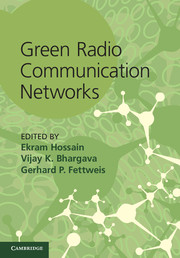Book contents
- Frontmatter
- Contents
- List of contributors
- Preface
- Part I Communication architectures and models for green radio networks
- 1 Fundamental trade-offs on the design of green radio networks
- 2 Algorithms for energy-harvesting wireless networks
- 3 PHY and MAC layer optimization for energy-harvesting wireless networks
- 4 Mechanical relaying techniques in cellular wireless networks
- Part II Physical communications techniques for green radio networks
- Part III Base station power-management techniques for green radio networks
- Part IV Wireless access techniques for green radio networks
- Part V Green radio test-bed, experimental results, and standardization activities
- Index
- References
2 - Algorithms for energy-harvesting wireless networks
from Part I - Communication architectures and models for green radio networks
Published online by Cambridge University Press: 05 August 2012
- Frontmatter
- Contents
- List of contributors
- Preface
- Part I Communication architectures and models for green radio networks
- 1 Fundamental trade-offs on the design of green radio networks
- 2 Algorithms for energy-harvesting wireless networks
- 3 PHY and MAC layer optimization for energy-harvesting wireless networks
- 4 Mechanical relaying techniques in cellular wireless networks
- Part II Physical communications techniques for green radio networks
- Part III Base station power-management techniques for green radio networks
- Part IV Wireless access techniques for green radio networks
- Part V Green radio test-bed, experimental results, and standardization activities
- Index
- References
Summary
Introduction
Carbon emissions due to various man-made devices are one of the main reasons for global warming. Green communications is largely concerned with reducing the carbon emissions caused during communications. One of the main reasons for carbon emissions in communication is the emission in generating the electrical energy consumed in communication networks. Soon, the electrical energy consumed in information and communication technology (ICT) related activities will be about 14% of all the electrical energy consumed in the world [1]. A large part of this is consumed in wireless communication networks (where the base station consumes most of the energy). Thus, reducing the carbon emission due to the energy used in wireless communications will have a significant environmental impact. This can be done in two ways. One of course is that we should reduce the electrical energy consumed in communications. Recent work has shown that the energy consumed can easily be reduced to one-third [1, 2]. The other way is to generate the energy used in a way that reduces (or totally eliminates) carbon emission. If one generates electricity via coal or gas installations, typically 800–950 gram CO2 (equivalent) is emitted per kwh. However, if one generates it via solar cells or wind turbines there is no emission at all [1, 2]. Therefore, there has been tremendous interest in using solar and/or wind energy at the base stations (BSs) of cellular systems [2].
Information
- Type
- Chapter
- Information
- Green Radio Communication Networks , pp. 24 - 52Publisher: Cambridge University PressPrint publication year: 2012
